LDRD R&D 100 Awards
2012
Solar Glitter

The key enabling technology for this approach to photovoltaics (PV) is the ability to create, through microsystems technology, very small solar cells made from high-quality crystalline silicon or gallium arsenide semiconductor materials. The cells are so small that, when released from their wafers, they take on the appearance of glitter. The cells are approximately 20 microns thick, 500 microns across, and composed of crystalline silicon. Efficiencies of nearly 15% have been demonstrated, exceeding 20% for single junction cells. Crystalline silicon and gallium arsenide make very good solar cells due to the high quality and performance of the material and semiconductor bandgap characteristics that are well matched to the solar spectrum.
However, these high quality materials are expensive. As much as 25% of the cost of a typical solar PV system comes from the silicon material alone. The Solar Glitter cells being manufactured at Sandia National Laboratories reduce the amount of silicon or gallium arsenide by at least a factor of ten.
Multiplexed Photonic Doppler Velocimeter

The Multiplexed Photonic Doppler Velocimeter (MPDV) is a portable optical velocimetry system that simultaneously measures up to 32 discrete surface velocities onto a single digitizer by multiplexing signals in frequency and time.
As recently as one year ago, scientists measuring shock wave surface velocities typically collected four channels of velocimetry data, and used extrapolation, assumptions and models to determine what was occurring in regions of the experiment that were not observed directly.
Thanks to advances in probes, digitizers and technology in telecommunications, scientists Ed Daykin and a team from National Security Technologies, LLC, with assistance from Lawrence Livermore researcher Ted Strand, were recently able to record 96 channels of data for a fraction of the original cost, using MPDV.
MPDV has been used at the Laboratory, Los Alamos National Laboratory and the Nevada National Security Site to gather velocimetry data on key national security work at unprecedented density and comprehensiveness.
UTurn Turns Waste, Chemistry and Materials Science Around
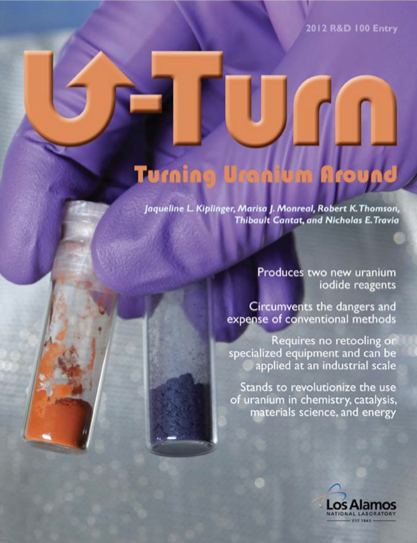
Los Alamos scientists developed a method that produces two new uranium iodide reagents. The cost-effective, environmentally green, and safe method will not only provide a nondestructive path forward for more than 5,300 metric tons of stockpiled nuclear waste but also stands to revolutionize the use of depleted uranium in chemistry, catalysis, materials science, and energy. This award was won by Jaqueline L. Kiplinger, Marisa J. Monreal, Robert K. Thomson, Thibault Cantat, and Nicholas E. Travia.
Digital Microfluidic Hub

A DNA sample-preparation system, Sandia’s digital microfluidic hub (DMH) cleverly uses tiny microdroplets of fluid as cargo containers to logically route DNA samples among different action-modules to prepare DNA for ultrahigh-throughput sequencing. Although sequencing itself is now a rapid endeavor, it can require days to prepare DNA for high-throughput sequencers. The DMH automates and greatly reduces this DNA-sample preparation time
Snowflake Power Divertor for Nuclear Fusion Reactors

Moving away from a fossil-fuel-based electricity supply is critical to sustain natural resources, reduce carbon emissions and stability. Magnetic fusion energy sources, such as doughnut-shaped tokamaks, could be a replacement.
A remaining key problem for a commercial tokamak is distributing the hot plasma exhaust of hundreds of megawatts over a sufficiently large wall surface area. Existing techniques magnetically divert the heat flux to specially designed plates, yet the projected power density is well beyond the capability of any material.
The Snowflake Power Divertor, developed by Lawrence Livermore National Laboratory researcher Dmitri Ryutov along with researchers at Princeton Plasma Physics Laboratory and the Center for Research in Plasma Physics in Switzerland, uses a previously unknown configuration of the divertor magnetic field whose shape is reminiscent of a snowflake. The resulting magnetic field lines spread the exhaust over a larger wall area and reduce the exhaust heat flux to manageable levels.
Installing the Snowflake in a newly built fusion facility does not lead to any cost increase. The Snowflake Divertor already has demonstrated large heat-flux reduction in tokamaks in Princeton, NJ, and Lausanne, Switzerland and will be installed in several facilities under design.
The Sandia Cooler

The roots of this notion date back to Sandia’s R&D100-winning fiber laser technology, a revolutionary leap in laser efficiency, a project in which Sandia staff member Jeff Koplow participated as team member and principal investigator in its last year. Because of their efficiency, fiber lasers converted much more of their input electrical energy to coherent light and less into waste heat. This meant that the elaborate and bulky water-based cooling systems required for traditional lasers might not be necessary for fiber lasers, thereby rendering them far more portable, particularly if they could be air-cooled.
However as Sandia follow-on projects succeeded in increasing the power of fiber lasers, it became apparent to Koplow that existing air-cooling systems would probably be unable to cope with the quantity of heat transfer that would likely be necessary, thereby defeating one of the great advantages of fiber laser technology. The wheels of his creative ideation began to turn.
Plastic Scintillators for Neutron and Gamma Ray Detection

Ensuring the United States remains safe from a nuclear or radiological attack has motivated the search for more definitive radiation detection and identification technologies. Detecting neutrons and gamma rays, and distinguishing one from the other, are key to identifying nuclear substances such as uranium and plutonium and differentiating them from benign radioactive sources.
A team of Lawrence Livermore National Laboratory researchers, led by Natalia Zaitseva and Steve Payne, has developed the first plastic material capable of efficiently distinguishing neutrons from gamma rays, something not thought possible for the past five decades or so.
With this major technology advance, pulse-shape discrimination using plastic scintillators can offer the same or even better resolution compared to standard commercial liquid scintillators, but without the associated and well-known hazards of liquids. Efficient pulse-shape discrimination combined with easy fabrication and advantages in deployment of plastics over liquids may lead to widespread use of the new materials as large-volume and low-cost detectors.
With the material's low cost, huge plastic sheets could be formed easily into larger surface areas than other neutron detectors currently used and could aid in the protection of ports, stadiums and other large facilities.
Sequedex Speed Reads DNA Using Evolutionary Theory
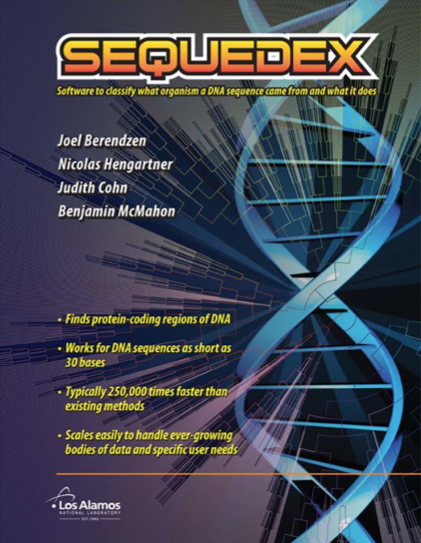
Sequedex is a revolutionary software package that can chew through one human genome’s worth of DNA analysis in 30 minutes on a single core of a laptop computer.
Sequedex makes it possible for a scientist to explore a community of microorganisms by analyzing the DNA from a spoonful of dirt, during the course of an afternoon, using equipment that could be carried on the back of a mule. Sequedex gets its performance boost by combining keyword recognition technology from web search engines with evolutionary theory, placing short “reads” of DNA from any organism on the Tree of Life.
This award was won by Joel Berendzen, Nicolas Hengartner, Judith Cohn, and Benjamin McMahon. Click here to download a fact sheet about Sequedex.
The Neutristor

From the outset of his LDRD project, Sandia researcher Juan Elizondo-Decanini’s had a guiding vision that prompted his creative research proposal. That vision was, in turn, guided by a “why not” question, namely, why wasn’t it possible to design and fabricate a neutron generator of a different geometry than those cylindrical tubes that had been employed for many decades? And if this conceptual redesign could be implemented, would it not then be possible to miniaturize this novel implementation?
2011
All-in-one RF Lets Mobile Devices Stay Small

Today’s mobile communications devices rely on an ever-increasing array of radio frequencies (RF), each of which requires its own acoustic filter. In the past, filters have typically been produced on their own dedicated circuits. Researchers at Sandia National Laboratories, Albuquerque, N.M., have invented a technology, Microresonator Filters and Frequency References, that combines filters on a single chip.
Biomimetic membranes for water purification

Commercial reverse osmosis (RO) membrane technology has advanced only incrementally over the last 30 years. However, Biomimetic Membranes for Water Purification, developed by Albuquerque-based Sandia National Laboratories and the University of New Mexico, represent a new approach to biomimetic membrane design and fabrication. The invention uses self-assembly and atomic layer deposition (ALD) to advance the field of membrane technology for water filtration.
NanoCluster Beacons: Shedding light on specific nucleic-acid targets
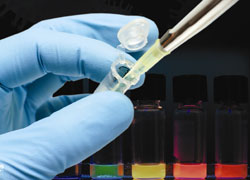
NanoCluster Beacons are collections of silver atoms designed to illuminate when bound to nucleic acids, such as the DNA of specific pathogens. Created at Los Alamos National Laboratory by Hsin-Chih (Tim) Yeh, James Werner, Jaswinder Sharma, and Jennifer Martinez, these beacons can be used to probe for diseases that threaten humans by identifying the nucleic acid targets that represent a person’s full genome, and allow for personalized medication. They can also be used in quantitative biology applications, such as counting individual molecules inside a cell.
Once bound with a specific target, a NanoCluster Beacon lights up, emitting fluorescence approximately 200 times greater than in the unbound state and easily viewed by the naked eye under ultraviolet light. The beacons come in an array of colors for multiplexed analyses, are more photostable than beacons used today, and can be turned on and off reversibly. Inexpensive, easy to use, and reversible, NanoCluster Beacons are superior molecular probes for detecting specific targets, human oncogene (cancer) sequences, and molecular disease sequences such as sickle cell anemia.
Th-ING: Thorium Is Now Green

"Th-ING was developed at Los Alamos National Laboratory by Jaqueline Kiplinger and Thibault Cantat as a straightforward, cost-effective, and safe method to produce thorium. Thorium is an element capable of producing more energy than both uranium and coal using significantly lower quantities. This element is only slightly radioactive, making it an excellent candidate for a future sustainable energy source. It is so safe that it will never lead to a nuclear meltdown when used in a nuclear reactor.
Before Th-ING, thorium could only be produced in hazardous settings at unreasonably high prices. This new method involves reacting thorium nitrate with aqueous hydrochloric acid under mild conditions, which can be performed using conventional glassware in a traditional laboratory setting. Then, a novel combination of anhydrous hydrochloric acid and trimethylsilyl chloride is used to remove coordinated water molecules, replacing them with dimethoxyethane to make the new thorium chloride reagent. The process cuts costs of production from $5,000 per kilogram to a mere $30 per kilogram and is “green”—as it does not produce wasteful solvent ring-opening/polymerization or waste thorium (95 percent production yields). With Th-ING, thorium becomes a practical and reliable source of energy for the future.
Glimpsing Fusion with the World's Fastest Light Deflector

Fusion, the world’s great promise for a source of clean and virtually limitless energy, could replicate the very process that powers the stars to meet our most pressing needs on Earth. Lawrence Livermore’s National Ignition Facility (NIF) is conducting experiments aimed at achieving fusion ignition and energy gain, the process whereby more energy is released than is required to initiate the fusion reaction. To better understand the physics of fusion and determine the minimum laser input energy needed to start the fusion process, researchers need to acquire accurate details of the burning plasma inside fusion targets. Recording such data with both fine time resolution and high dynamic range, however, presents enormous challenges for existing instruments given the trillionths-of-a-second time frames at which these reactions will occur.
A novel solid-state optical device developed at the Laboratory by engineers John Heebner, Susan Haynes, and Chris Sarantos (formerly of Livermore) may provide a solution to the problem. The serrated light illumination for deflection-encoded recording (SLIDER), recently honored with an R&D 100 Award, is the world’s fastest light deflector. When mated to an ordinary camera, it can record optical signals on picosecond (trillionth of a second) timescales. When combined with a high dynamic range camera, SLIDER can maintain this high temporal resolution and a high dynamic range—two performance parameters that are difficult to meet simultaneously.
Lightweight, Scalable Tool Identifies Supercomputers' Code Errors

Consider the common desktop computer. The hardware that runs all of an application’s many independent execution units, or processes, is called a core. Most desktops have between one and four cores. These computers cost between a few hundred and a few thousand dollars. In contrast, today’s largest supercomputers contain hundreds of thousands of cores and cost hundreds of millions of dollars. The scientific applications these computers run—which often culminate from decades of multiperson development efforts—are equally costly. Single faults, or bugs in the codes, that disable only one process can halt an application’s execution. During the resulting debugging process, developers use up their time locating the bugs, with delays consuming machine hours and racking up significant costs.
Extreme-scale systems present an additional hurdle. Current debugging tools were never designed to scale to such sizes. Therefore, at scales of a thousand processes, these tools can take minutes to perform a single debugging operation, and typically, each operation is performed tens to hundreds of times during just one debug session. “Our debugging tool is our response to this problem,” says computer scientist Greg Lee. Lee and fellow Livermore computer scientists Dong Ahn, Bronis de Supinski, Matthew LeGendre, and Martin Schulz, with collaborators at the University of Wisconsin at Madison and the University of New Mexico, designed and developed a unique R&D Award–winning solution called the stack trace analysis tool (STAT). The tool can identify errors in code running on today’s largest machines. It will also work on the even larger machines expected to roll out over the next several years.
2009
Speeding Airport Security, Increasing Passenger Safety

MagViz, a 2009 R&D 100 Award winner from Los Alamos National Laboratory, is the first product based on a new form of magnetic resonance imaging (MRI)—a form that uses ultralow magnetic fields. Like traditional MRI, MagViz identifies chemicals by measuring the magnetic interactions of their protons with the local molecular environment. However, to measure the proton signal, MagViz uses an applied external magnetic field about 10,000 times weaker than that used with traditional MRI and therefore provides a proton signal whose frequency is 10,000 times lower than traditional MRIs. This signal is detected using highly sensitive magnetic-field detectors called superconducting quantum-interference devices, or SQUIDs. Traditional MRI uses radio receivers.
The ultra-low-field MRI technology used in MagViz was developed with funding from the LDRD program. Click here to download a fact sheet about MagViz.
Applications:
- Detection of liquid explosives in airport carry-on luggage
- Medical imaging for patients for whom traditional MRI is unsafe (e.g., people with active medical implants, pregnant women, or soldiers with embedded shrapnel)
- Medical imaging in remote or underdeveloped areas (e.g., battlefields, accident sites, rural areas, Third World countries)
- Quality control on production lines
Process pulls CO2 from fossil fuel plants

Winner of a 2009 R&D 100 Award, the SIMTECHE CO2 Capture Process from Los Alamos National Laboratory, and SIMTECHE, Redding, Calif., provides low-cost CO2 separation and compression capable of removing 65% to 90% or more of the CO2 emitted by fossil fuel power plants and other operations. Based on the reversible reaction of CO2 and cold water, the process pulls CO2 out of flowing mixtures of gases and traps individual CO2 molecules within tiny molecular cages made of water. Once separated from the gas stream, the CO2 hydrate can be decomposed to regenerate CO2 gas at elevated pressures for sequestration or sale on the emerging CO2 market. Informed control of thermodynamic conditions throughout the process and efficient reactor design reduce parasitic power losses and minimize incremental costs. The SIMTECHE CO2 Capture Process is proven and now poised to reduce CO2 emissions at industrial scales.
The initial scientific capability for this work was developed with support from the Los Alamos LDRD program.
Applications:
- Captures CO2 emitted by integrated gasifier combined-cycle (IGCC) power plants burning coal, petroleum coke, natural gas, or biomass
- Captures CO2 emitted by coal-fired power plants using high-purity oxygen for combustion
- Compresses CO2 and hydrogen sulfide (H2S) for use in enhanced oil recovery or sequestration in underground geological formations
- Purifies high-pressure hydrogen for use in hydrotreating, petrochemical synthesis, and refinery operations
Artificial retina: Restoring sight to the blind

Researchers at five national laboratories, four universities, and an industrial partner have developed the Artificial Retina, a retinal prosthesis that can be used to treat age-related macular degeneration and inherited retinal disorders such as retinitis pigmentosa. The device uses application-specific integrated circuits to transform digital images from a camera into electrical signals in the eye that the brain uses to create a visual image. The system features a video camera and transmitter mounted in sunglasses, a visual processing unit, and a battery pack to power the device that is worn on the belt. The retinal implant receives a signal via wireless transmission, encodes it into specific patterns of stimulation pulses that are conducted through a cable to the electrode array that stimulates the retina. The brain perceives the patterns of light spots corresponding to the stimulated electrodes. In clinical trials, patients with vision loss were able to identify objects, increase mobility and detect movement.
LDRD researchers from Lawrence Livermore National Laboratory, Los Alamos National Laboratory and Sandia National Laboratories contributed to this work. For more information about the project, visit the U.S. Department of Energy's Artificial Retina Project online.
LASONIX: A new method to fabricate 3-D microelectronics
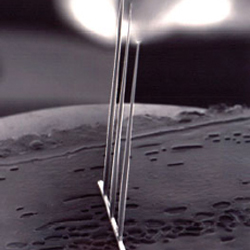
Lasonix is a new approach for fabricating insulators, semiconductors, and metallic conductors to form standard semiconductor microcircuits, metallic connections and pathways, and vertically integrated circuits. The fabrication method grows electronics in three dimensions, rather than on a particular substrate, allowing for vertical interconnection and integration of planar substrates into electronic “blocks” or micromodules. In addition, microscale vacuum electronics, high-frequency electromagnetic devices, optoelectronics, and power-switching electronics can all be created with Lasonix, thus enabling hybrid systems to be fabricated. Vast improvements in device and system performance can be achieved through vertical integration of complex micromodules and devices. Lasonix combines all the advantages of a rapid prototyping technology with advanced microelectronics fabrication.
The initial scientific capability for this work was developed with support from the Los Alamos LDRD program. Click here to download a fact sheet about Lasonix.
Applications:
- 3-D semiconductor devices for high-speed systems
- Power electronic switching systems
- Specialized power relays
- Hybrid optical, semiconductor, and terahertz systems
Femtoscope
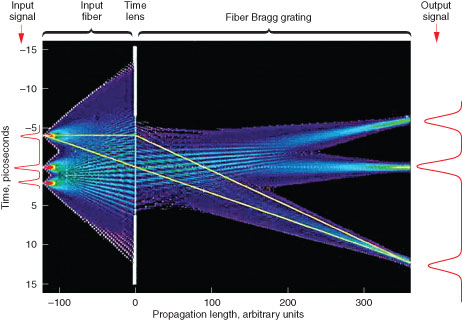
To meet the emerging need for greater dynamic range and temporal resolution in high-energy-density-physics and fusion - energy research diagnostics, scientists can turn to the new FemtoScope - a "time microscope" that is attached to the front end of a conventional recording instrument to dramatically improve its performance. The FemtoScope - developed at Lawrence Livermore National Laboratory in collaboration with colleagues from Stanford University, the University of Southampton, and the University of California at Davis - improves the performance of an oscilloscope or streak camera much in the same way that a high-performance lens improves a camera's output. When combined with an oscilloscope, the FemtoScope produces an instrument capable of recording 100-picosecond frames at 155 million frames per second until its memory is full. When combined with an optical streak camera, the FemtoScope produces an instrument with a 20-times increase in temporal resolution and a 30-times increase in dynamic range, resulting in an overall improvement of 600 times compared with the performance of the streak camera alone.
Precision Robotic Assembly Machine

Historically, building laser fusion targets required a significant amount of handcrafting skill and technique involving microscopes and manually driven fixtures. Now, scientists at Lawrence Livermore National Laboratory, along with collaborators from General Atomics in San Diego, California; Aerotech, Inc., in Pittsburgh, Pennsylvania; and Indicate Technologies, Inc., in Santa Clara, California, are transforming the way fusion targets are manufactured with a new device called the precision robotic assembly machine. The precision robotic assembly machine can manipulate tiny fusion target components with unprecedented precision in an operating arena the size of a sugar cube. Unlike in other machines, the innovative use of visual and force feedback allow an operator to drive the machine like a surgical robot and automate the assembly process. Furthermore, the precision robotic assembly machine demonstrates improved target quality and a tenfold reduction in manpower needed to assemble laser fusion targets.
ROSE Compiler Infrastructure

Computer scientists at Lawrence Livermore National Laboratory have radically altered the programming landscape by creating ROSE, an open-source customizable compiler infrastructure that gives all computer programmers easy access to complex, automated compiler technology and assistance. ROSE accepts code in today's most common programming languages, including C, C++, and Fortran. Compiling is converting human-friendly source code into the machine-friendly binary code a computer needs to execute a program (that is, "executable" files). The conversion of source code into binaries is performed by specialized software applications called compilers. Because ROSE has full knowledge of common programming languages, it can be used to optimize code performance and find errors. For example, millions of lines can be scanned for source-code defects (bugs that are allowed by the programming language but still cause system failures when run) or malicious elements hiding in the code. Additionally, ROSE returns these improvements to the user in revised source code rather than in the form of machine-readable binaries.
Land Mine Locator

The Landmine Monitor Report 2008 assesses that many thousands of square kilometers of land are contaminated by up to 100 million mines and other explosives. In 2007, about 1,400 people were killed and 4,000 injured by mines or other explosive remnants of war. Furthermore, the pace of mine removal is far slower than the rate at which new mines are being placed. Researchers from Lawrence Livermore National Laboratory, together with colleagues at First Alliance Technologies, LLC, in San Ramon, California, and Hystar Aerospace Corporation in Vancouver, Canada, has developed the land mine locator. It is an aerial detection system equipped with Livermore's LANDMARC (land mine detection advanced radar concept), which features an ultrawideband radar-sensing technology called iRadar and tomographic algorithms that provide three-dimensional subsurface images. LANDMARC is deployed on the remotely operated Hystar aerial platform, thereby reducing the time and cost of demining while significantly improving the safety of personnel and equipment. Other potential applications for the land mine locator are the detection of roadside bombs and improvised explosive devices.
Nanocoral
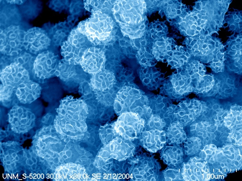
As a precious metal, platinum metal is crucial as a catalyst in many electrochemical processes; for example, in automobile catalytic converters to catalyze the reaction of carbon monoxide (CO) and unburned fuel from a car's exhaust with oxygen to form carbon dioxide (CO2) and water vapor (H2O). Fuel cells, devices that combine hydrogen and oxygen to produce electricity and water, also use platinum as a catalyst, but platinum has now become particularly crucial in the renewable energy arena as a catalytic component in solar cells. Until now, the extant methodologies for producing platinum nanoparticles have not provided extensive control with respect to the size, shape, porosity, composition, and stability of such particles, but with Nanocoral, the ability to control such properties in the production of platinum nanoparticles — by way of templated dendritic growth— leads to exquisite micro- and nanostructures that have been shown to not only facilitate catalysis, but to preserve the high surface-area and catalytic activity, resisting the process of “ripening,” that normally degrades such activity. This ultimately promises to reduce platinum metal consumption and thus the cost of platinum catalysts for use in the renewable energy sector. Sandia National Laboratories researcher John Shelnutt worked with Bob Comstock and Roland Degenkolbe of Compass Metals, Inc., Sandians Yujiang Song, James E. Miller, and Frank van Swol, and Sivakumar Challa and Craig Medforth of the University of New Mexico.
LDRD was the primary funding source. Funding from a CRADA with Toyota and DOE/BES funds also contributed.
Ultralow-Power Silicon Microphotonic Communications Platform

Although best illustrated by current supercomputers and by global data centers, such as Google, the enormous energy consumption by these computational resources is growing, and is likely to become the limiting factor in further growth (approaching Gigawatt power consumption levels — for comparison, the hydroelectric power production of Hoover Dam is one gigawatt). By and large, this consumption is governed by electrical interconnects within and between processing chips. These electrical communication links greatly limit bandwidth, such that, for example, in multi-core and parallel computing, most microprocessor compute cycles among microprocessors, memory and a network are spent in “wait states” (i.e., waiting for data), as the inadequate bandwidth of electrical links is unable to pass data with sufficient speed. This results in an average of only 15% computational efficiency. Developed by researchers at Sandia National Laboratories, Ultralow-Power Silicon Microphotonic Communications Platform offers an extremely small, optical-routing solution to interconnectivity that potentially consumes 100- to 1000-fold less power, with a 100-fold increase in bandwidth, thus taking an important step toward lowering power consumption and increasing data transfer rates in computation, especially in the realm of supercomputers and data centers. The silicon modulator element has a diameter of only 4 µm, demonstrates a bit-error rate below 10–12 for 10 gigabit per second data transmission and requires only 75 femtojoules (10–15J) per bit power consumption, making it the smallest, highest-speed, and lowest-power resonant silicon modulator demonstrated to date. The work was led and submitted by Michael Watts, with Douglas Trotter, Ralph Young, Anthony Lentine, and David Luck.
LDRD and DARPA were the funding sources for this project.

